Gonatidae
Tsunemi Kubodera, F. G. Hochberg, Richard E. Young, and Michael Vecchione


This tree diagram shows the relationships between several groups of organisms.
The root of the current tree connects the organisms featured in this tree to their containing group and the rest of the Tree of Life. The basal branching point in the tree represents the ancestor of the other groups in the tree. This ancestor diversified over time into several descendent subgroups, which are represented as internal nodes and terminal taxa to the right.

You can click on the root to travel down the Tree of Life all the way to the root of all Life, and you can click on the names of descendent subgroups to travel up the Tree of Life all the way to individual species.
For more information on ToL tree formatting, please see Interpreting the Tree or Classification. To learn more about phylogenetic trees, please visit our Phylogenetic Biology pages.
close boxIntroduction
Gonatids are mostly muscular squids of moderate size but are unusual in having the armature on the arms in four, rather than two, series (occasionally more than four series near the arm tips) (see title photographs). The two medial series are usually hooks. Often the tentacular club has one very large centrally located hook. Species of the genus Gonatopsis are unusual in that they lack tentacles which are lost in the early juvenile stage.
Brief diagnosis:
An oegopsid ...
- with tetraserial armature on arms.
- usually with hooks on arms and often on tentacular clubs.
Characteristics
- Arms
- Arms with quadraserial armature except at arm tips in some species where sucker series increases.
- Arms I-III with hooks in two medial series except in Berryteuthis anonychus; the latter with hooks only in females and only at bases of arms I-III.
 Click on an image to view larger version & data in a new window
Click on an image to view larger version & data in a new window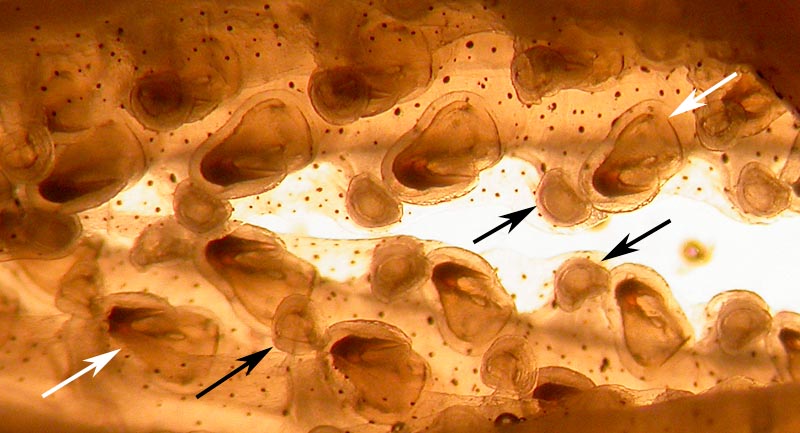
Figure. Oral view of two arms of Gonatus steenstrupi with large hooks in the medial two series (white arrows) and a series of small suckers on each arm margin (black arrows). Transmitted-light photograph by M. Vecchione aboard the R/V G. O. SARS, MarEco cruise to the central North Atlantic.
- Tentacles
- Tentacular clubs with numerous irregular series of suckers; additional hooks in some genera.
- Tentacular clubs with unique locking-apparatus in Gonatus and Eogonatus consisting of a series of elongated ridges with medial suckers and knobs.
 Click on an image to view larger version & data in a new window
Click on an image to view larger version & data in a new window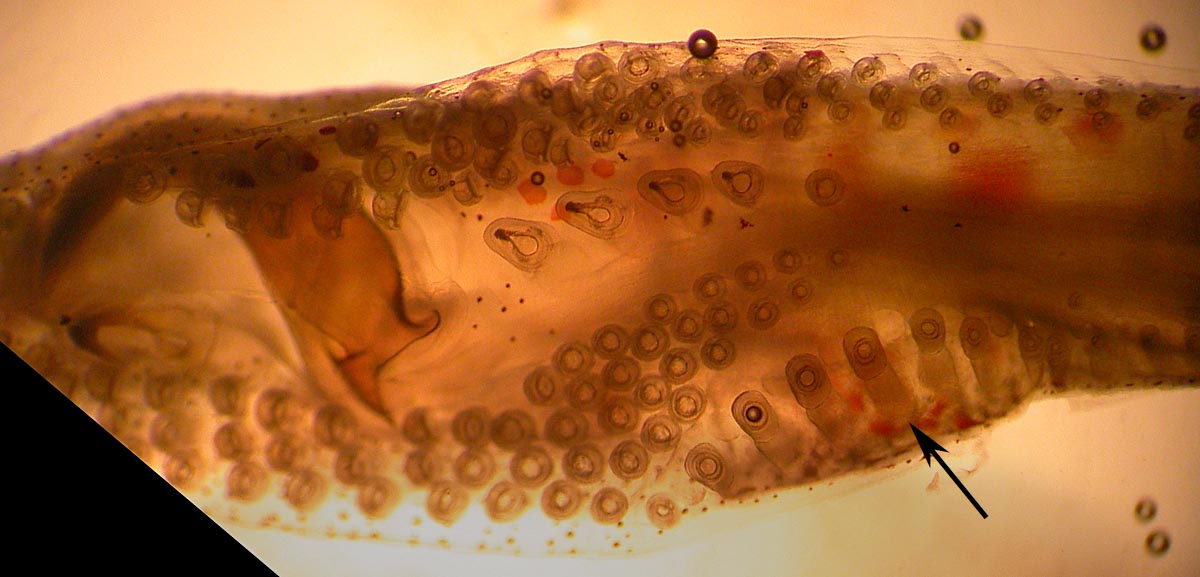
Figure. Oral view of the proximal region of the club of G. steenstrupi. Arrow points to one ridge of the locking-apparatus. Transmitted-light photograph by M. Vecchione aboard the R/V G. O.SARS, MarEco cruise to the central North Atlantic.
- Buccal crown
- Buccal-crown connectives attach to ventral margins of arms IV.
- Buccal-crown connectives attach to ventral margins of arms IV.
- Funnel
- Funnel locking-apparatus with straight groove.
- Funnel locking-apparatus with straight groove.
- Photophores
- Photophores absent except in G. pyros (ocular photophores).
- Photophores absent except in G. pyros (ocular photophores).
- Gladius
- Gladius with primary conus.
Comments
The following table compares characteristics of subadults for the genera of Gonatidae.
| Genus / Character | Tentacles present | Hooks present on clubs | Club locking-apparatus |
| Berryteuthis | Yes | No | Single series of suckers and knobs along entire dorsal margin of manus. |
| Eogonatus | Yes | No | Short series of suckers, knobs and elongate ridges at base of manus. |
| Gonatopsis | No | NA | NA |
| Gonatus | Yes | Yes | Short series of suckers, knobs and elongate ridges at base of manus. |
Discussion of Phylogenetic Relationships
There have been several recent attempts to unravel the phylogeny of the Gonatidae. Nesis (1997) relied on similarity of morphology and, apparently, results of protein electrophoresis by Katugin (1993 and 1995) to derive the following relationships:


Figure. Phylogeny of the Gonatidae. Chart modified from Nesis (1997). Subgenera are in red. Nesis included only species that were well established as valid species. Nesis considered Eogonatus to be a subgenus of Gonatus.
Clearly if this phylogeny is correct then Gonatopsis is polyphyletic. More recently Katugin (2004) has reassessed the phylogeny of the gonatidae using electrophoretic analysis of allozymes. His results are seen below.

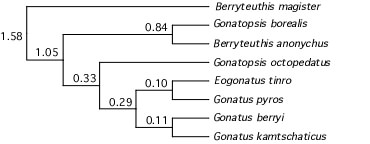
Figure. Phylogenetic tree of the Gonatidae. Chart modified from Katugin (2004). Numbers represent genetic distance based on protein electrophoresis. Branch lengths are not drawn proportional to genetic distance.
In the paper Katugin proposes a new classification of the Gonatidae with two subfamilies (Berryteuthinae and Gonatinae) based on the radula. Within the Berryteuthinae he includes Berryteuthis (B. magister), Boreoteuthis (for Gonatopsis borealis; he elevates the subgenus Boreoteuthis to generic level) and a new genus Okutania for Berryteuthis anonychus. In the Gonatinae he includes Gonatus (including Eogonatus) and the remaining species of Gonatopsis. Katugin's phylogeny based on allozymes is similar to that of Nesis (1997) however the allozyme data shows the Gonatinae nested within the Berryteuthinae.
Recent molecular data analyzed using parsimony from 12S rRNA, 16S rRNA, and COI genes (Lindgren et al. 2005) offer a somewhat different phylogeny of the family but without good bootstrap support for most nodes. This data suggests that the Gonatus is paraphyletic. Gonatopsis borealis groups more closely with Berryteuthis than other species of Gonatopsis as suggested by both Nesis (1997) and Katugin (2004).

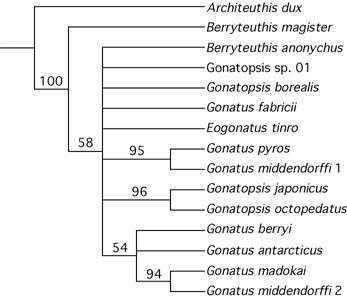
Figure. Phylogenetic tree of the Gonatidae. Chart simplified from Lindgren et al. (2005) by collapsing nodes with bootstrap support of 50 or less, and eliminating uncertain identifications. Numbers represent bootstrap support for relationships derived from combined molecular analyses. Numberered G. middendorffi represent different morphological types.
Because of the uncertainty in gonatid phylogeny, we retain here the standard classification for the family.
Nomenclature
A list of all nominal genera and species in the Gonatidae can be found here. The list includes the current status and type species of all genera, and the current status, type repository and type locality of all species and all pertinent references.
Habitat and distribution
Gonatids are pelagic squids that occur from the surface to over 1000 m depth. Some species undergo extensive diurnal (diel) vertical migrations, ascending at night and descending during the day. A few species are associated with the ocean floor over the continental slope. Gonatids occur in high latitudes of both hemispheres. One species lives in antarctic waters, two in the North Atlantic and 16 in the high North Pacific where they are among the most abundant oceanic squids.
Life History
Historically the paralarvae of gonatid squids have been virtually impossible to identify. Recent studies, however, found that the dorsal-head chromatophores can allow specific identification of the smallest paralarvae of at least six species in the North Pacific (Jorgensen, 2006). Jorgensen (2006) recognizes two basic patterns, Type 1 and Type 2, with species-specific variations in each.

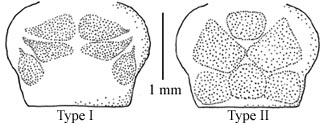
Figure. Dorsal view of the two classes of head chromatophores presently recognized in gonatids. Type I has three tear-shaped chromatophores on each side that come to a point over each eye. Type II has three transverse rows of chromatophores with one chromatophore in the anterior row, two in the middle row and three in the posterior row. Drawings from Jorgensen (2007).
References
Jorgensen, E. M. 2007. Identification, distribution and relative abundance of paralarval gonatid squids (Cephalopoda: Oegopsida: Gonatidae)from the Gulf of Alaska, 2001-2003. Journ. Molluscan Studies, 73: 155-165.
Katugin, O. N. 1993. Study of relationships between different species of squid, family Gonatidae, by protein electrophoresis. In: Biology and Rational Use of Hydrobionts. Their role in ecosystems. Abstracts of communications of the TINRO Young Scientisit Conference, Vladivostok," p. 14-15. In Russian.
Katugin, O. N. 1995. Morphology, genetic difference, and evolution of Berryteuthis magister, Berriteuthis anonychus, and Gonatopsis borealis (Cephalopoda: Oegopsida). In: "Unitas Malacologica. 12th International Malacological Congress. Vigo, Spain. Abstracts." p. 312-313.
Katugin, O. N. 2004. Squids of the family Gonatidae from the North Pacific Ocean and their genetic differentiation: controversial issues in the systematics and phylogeny.Ruthenica 14(1): 73-87. In Russian with English abstract.
Lindgren, A. R., O. N. Katugin, E. Amezquita and M. K. Nishiguchi. 2005. Evolutionary relationships among squids of the family Gonatidae (Mollusca: Cephalopoda) inferred from three mitochondrial loci. Molecular Phylogenetics and Evolution 36(1):101-111.
Nesis, K. N. 1982. Abridged dey to the cephalopod mollusks of the world's ocean. 385+ii pp. Light and Food Industry Publishing House, Moscow. (In Russian.). Translated into English by B. S. Levitov, ed. by L. A. Burgess (1987), Cephalopods of the world. T. F. H. Publications, Neptune City, NJ, 351pp.
Nesis, K. N. 1997. Gonatid squids in the Subarctic North Pacific: Ecology, biogeography, niche diversity and role in the ecosystem. Advances in Marine Biology. Academic Press, New York, p. 243-324.
Okutani, T. and M. R. Clarke. 1992. Family Gonatidae Hoyle, 1886. P. 139-156. In: Sweeney, M. J., C. F. E. Roper, K. M. Mangold, M. R. Clarke and S. v. Boletzky (Eds.). "Larval" and juvenile cephalopods: A manual for their identification. Smithson. Contr. Zool. No. 513.
Young, R. E. 1972. The systematics and areal distribution of pelagic cephalopods from the seas off Southern California. Smithson. Contr. Zool., 97: 1-159.
Title Illustrations

| Scientific Name | Gonatopsis borealis, Gonatus berryi |
|---|---|
| Location | Northeast Pacific off Oregon,U.S.A., at 46.16°N, 124.79°W; off Monterey at 36.7°N, 122.05°W |
| Comments | In situ photographs of G. borealis taken at a depth of 701 m (daytime); G. berryi taken at a depth of 726 m |
| Acknowledgements | Image courtesy of the Monterey Bay Aquarium Research Institute (MBARI). You must obtain permission from MBARI to use this photo; please contact pressroom@mbari.org for further information. |
| Specimen Condition | Live Specimen |
| Identified By | R. E. Young |
| View | Side; oral |
| Size | Unknown; 185 mm ML |
| Copyright | © 2013 MBARI |
About This Page

National Science Museum, Tokyo, Japan
F. G. Hochberg

Santa Barbara Museum of Natural History, Santa Barbara, California, USA

University of Hawaii, Honolulu, HI, USA

National Museum of Natural History, Washington, D. C. , USA
Page copyright © 2019 , F. G. Hochberg, , and
 Page: Tree of Life
Gonatidae .
Authored by
Tsunemi Kubodera, F. G. Hochberg, Richard E. Young, and Michael Vecchione.
The TEXT of this page is licensed under the
Creative Commons Attribution-NonCommercial License - Version 3.0. Note that images and other media
featured on this page are each governed by their own license, and they may or may not be available
for reuse. Click on an image or a media link to access the media data window, which provides the
relevant licensing information. For the general terms and conditions of ToL material reuse and
redistribution, please see the Tree of Life Copyright
Policies.
Page: Tree of Life
Gonatidae .
Authored by
Tsunemi Kubodera, F. G. Hochberg, Richard E. Young, and Michael Vecchione.
The TEXT of this page is licensed under the
Creative Commons Attribution-NonCommercial License - Version 3.0. Note that images and other media
featured on this page are each governed by their own license, and they may or may not be available
for reuse. Click on an image or a media link to access the media data window, which provides the
relevant licensing information. For the general terms and conditions of ToL material reuse and
redistribution, please see the Tree of Life Copyright
Policies.
- Content changed 08 January 2013
Citing this page:
Kubodera, Tsunemi, F. G. Hochberg, Richard E. Young, and Michael Vecchione. 2013. Gonatidae . Version 08 January 2013. http://tolweb.org/Gonatidae/19414/2013.01.08 in The Tree of Life Web Project, http://tolweb.org/





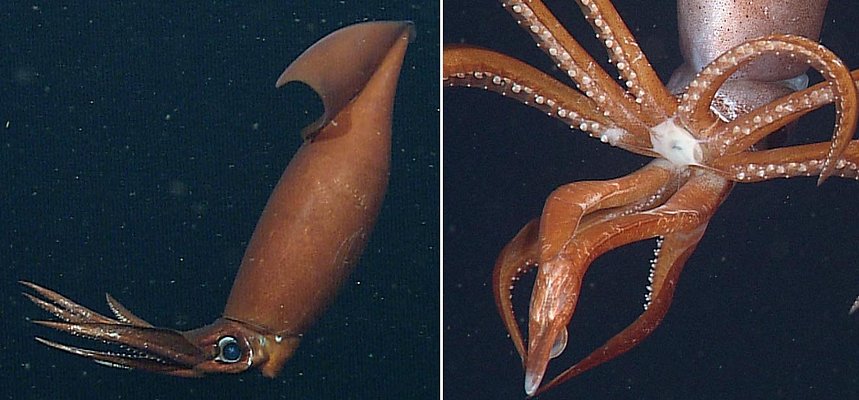


 Go to quick links
Go to quick search
Go to navigation for this section of the ToL site
Go to detailed links for the ToL site
Go to quick links
Go to quick search
Go to navigation for this section of the ToL site
Go to detailed links for the ToL site